Growing Blueberries? Avoid these 4 Beginner Mistakes
updated October 2021
Is it possible to successfully grow blueberries in your home garden? YES!
When I began gardening in 2013, growing blueberries topped my list of garden priorities. One of the most healthy fruits you can eat, the flavor of store-bought blueberries simply can’t compare to homegrown.
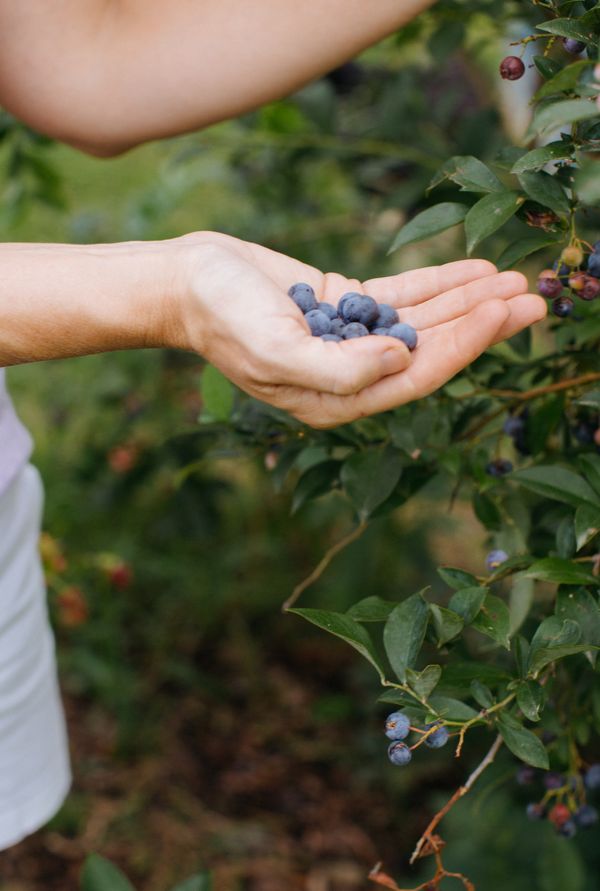
And for those on a budget, growing your own blueberries will save hundreds of dollars over the years compared to buying from the grocery store. If you’re successful, you may find yourself harvesting more than you can eat, and you can sell them to actually earn some extra cash!
But back to the question — how can we become successful at growing blueberries in our home gardens?
It’s actually much simpler than you would think. All the work — which is minor in comparison to other plants — comes in the first year. After their first season, blueberries are low-maintenance and will produce buckets full within a couple of years!
Before I planted my first bushes in the ground, I researched the requirements of growing blueberries right from the beginning. From both the knowledge I gained from research and my own gardening experience with my 8-year-old blueberry bushes, I’ve compiled the most common beginner mistakes in growing blueberries and how to avoid them.
*links below may contain affiliate links, which means if you click through and make a purchase, I’ll earn a commission at no extra cost to you.
Mistake #1: Only planting one blueberry bush
Some blueberry cultivars are partially self-pollinating, but some are not. For those that are not (like rabbiteye blueberries commonly grown in the southern US), this means at least two different varieties are necessary to fully pollinate one another. If only one of these bushes is grown, flowers will form but berries will not.
But even partially self-pollinating cultivars (generally northern highbush and southern highbush), planting more than one bush of a different cultivar will yield more berries each year.
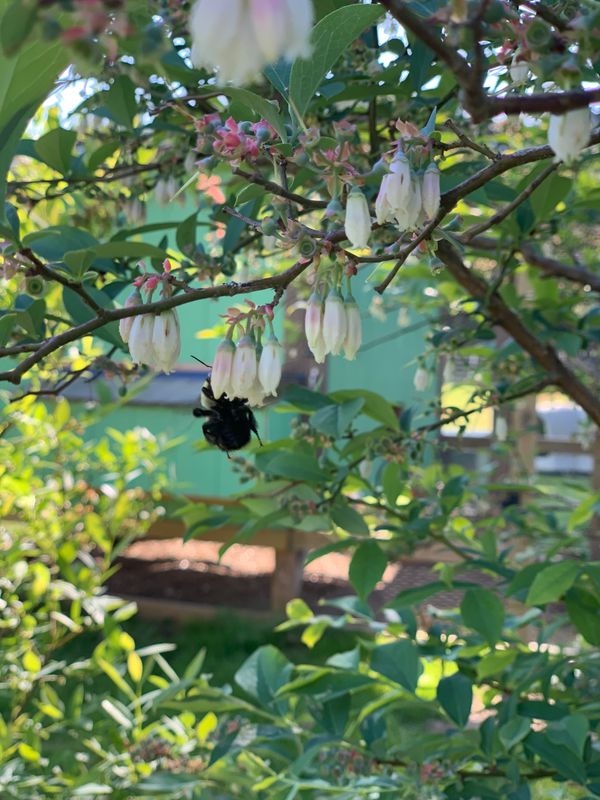
So, regardless of which cultivar you grow, for the best fruit production, you want at least two bushes.
However, I’d suggest planting even more if possible. The more diversity you can include, the better. This is not only the case for abundant fruit set (though that’s a great reason in itself), but different cultivars will flower and set fruit at different times. This can be advantageous for several reasons.

The most obvious is the longer period of harvest. If you have early season, mid season, and late season blueberry bushes, you will be able to harvest for weeks or even months in succession.
When I planted my main blueberry planting, I chose to purchase five different cultivars. Though I didn’t plan it this way, each of them ripens at slightly different times. Not only do I harvest gallons each season from these bushes, but also I harvest for a solid two months.

But there’s another reason why planting cultivars with different ripening times can be advantageous. If your bushes get hit with a late freeze (like mine did — twice — in 2021), the early season cultivar may be the only one affected, whereas you can still count on a large harvest from the later ones.
(Not sure what cultivar to choose? Learn more about which cultivars to choose for your area in this post about growing blueberries in containers or in the ground. )
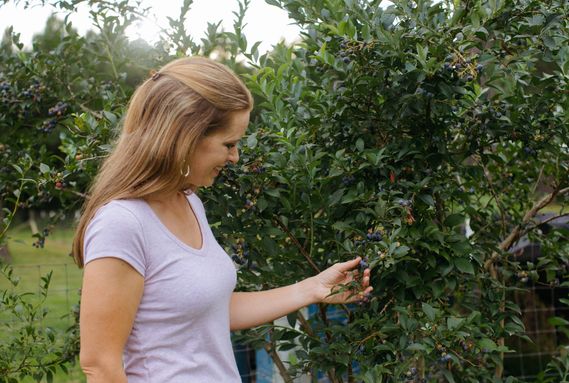
Mistake #2: Not checking the soil before planting your blueberries
Most garden plants tolerate a variety of pH levels in the soil, but this is not the case with blueberries. Blueberry bushes must have acidic soil — between 4.0 and 5.0 is ideal.
Many garden soils are more likely to swing toward the acidic, particularly in regions like the eastern, southeastern and pacific northwest in the US. But if even if you live in one of those regions, I wouldn’t recommend assuming that’s the case and hoping for the best.
Blueberry bushes will last years, if not decades, and it’s worth your time to start them out right.
How do you know if your soil is acidic? The safest bet is to test your soil. I use SoilKit (*affiliate link) to test my soil. They mail the testing kit to you with instructions, you take a sample and mail it back in a postage-paid package, and they email you the results within a few days.
(New to soil testing? Here’s more about soil testing — the how and why behind it.)
Growing Blueberries Where Soil Isn’t Acidic
If your soil is not acidic and you want to grow blueberries, you have a couple of options:
- amend your current soil with elemental sulfur
- build a raised bed and use an acidic soil blend
- plant in large containers with an acidic soil mix
Whether you amend your soil with elemental sulfur, build a new raised bed with an acidic soil blend, or plant in large containers using an acidic soil mix, blueberry expert Dr. Lee Reich shares more details on how to acidify your soil (even the first year) in this post.
In the video below, my friend and I tested a future blueberry planting area and amended it according to the recommendations from SoilKit. You can see our process of testing and amending in the first 7 minutes:
Growing Blueberries Where Soil Is Acidic
Even if your soil is in the proper acidic range of 4.0 to 5.0, it’s a good idea to amend the planting area with peat moss and other organic matter. You can also include pine needles and coffee grounds (many coffee shops will give you their used coffee grounds for free). Note that pine needles and coffee grounds won’t likely lower the soil’s pH, but it can help to add organic matter and keep the pH low.
A note on the acidity of peat moss
Also note that when adding peat moss (whether you’re trying to lower pH or maintain low pH), not all peat offers the same acidity level. According to this article from Iowa State, only Canadian peat moss (with a pH of 3.0 – 4.5) will lower pH. Many sources of peat from garden centers are neutral or only slightly acidic, which may still be too high for blueberries.

Other Requirements for Soil
If the pH of the soil is in line, blueberry bushes generally don’t require much. They do not require highly fertile soil, but soil rich in organic materials will give them the best start. If you’re planting blueberries for the first time and the pH is in the ideal acidic range, don’t worry with fertilizing the first year; just add plenty of organic matter.
After the first year, just as the bushes start to break dormancy, you can add an organic slow-release nitrogen source like cottonseed meal, soybean meal, or composted chicken manure. Personally, I only have to do this every couple of years. Blueberries really aren’t that picky with soil beyond the pH.
Mistake #3: Not mulching your blueberry bed
Blueberries have shallow root systems. This means the roots can dry out if a thick mulch isn’t used to protect from evaporation. Plus, this mulch will help retain moisture already present in the soil from which the blueberry roots can draw.
I cover my beds with 2-4 inches of wood chips or pine needles in both the spring and the fall, though other options will work will blueberries as well. Here is a more in-depth discussion of mulch options.
Another benefit mulch has is preventing weed growth. Again, being shallow-rooted, blueberry bushes will suffer from competition for water and nutrients.
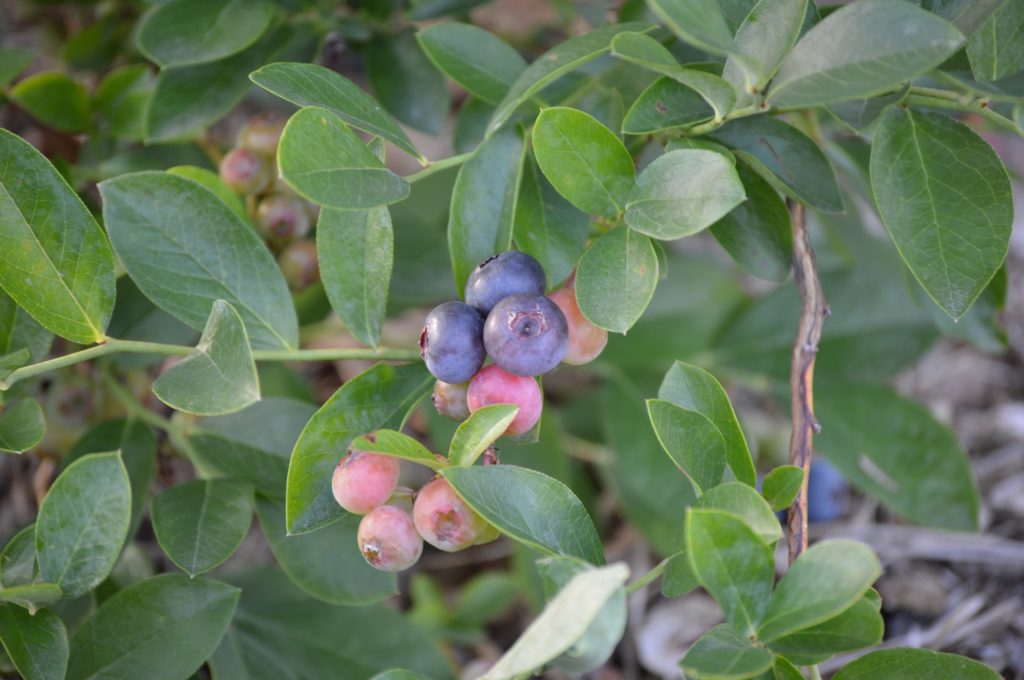
Mistake #4: Planting your blueberries in a poorly-drained location
Blueberries do not like “wet feet,” so choosing a site with good drainage is important when selecting where your blueberry bushes will grow.
My garden area is typically not well-drained, but my blueberry bushes have thrived. Why? One reason, I believe, goes back to how much organic matter (pine needles and composted wood chips) I added to the soil to begin with, in addition to the thick layer of mulch. These steps I believe prevent my normally wet soil from causing any problems for my bushes.
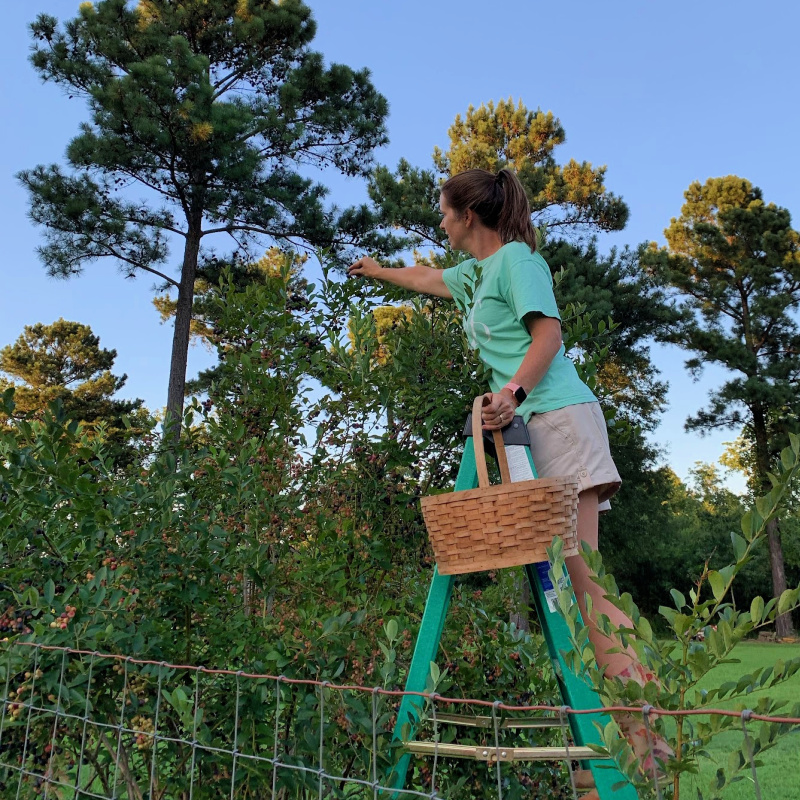
Still, making sure your blueberry bed is well-draining — or at the very least, well-amended — is important for the future growth of your bushes. Remember, these are not annual crops. Where you choose to plant your bushes the first year makes all the difference, and unless you make an effort to relocate them (which I wouldn’t recommend), where you plant them is where they will stay.
But what about watering? We know they don’t like soil that tends to hold water, but how much water do they need? In generally, you want to make sure they are watered very deeply at planting and then supplement with irrigation that first year if rainfall doesn’t provide at least 1″ of water per week.
In my experience, once my bushes were established, I haven’t had to water at all. Granted, we have wet springs, but our summers and falls are dry. The key is to make sure they get plenty of water their first year or two of growth.
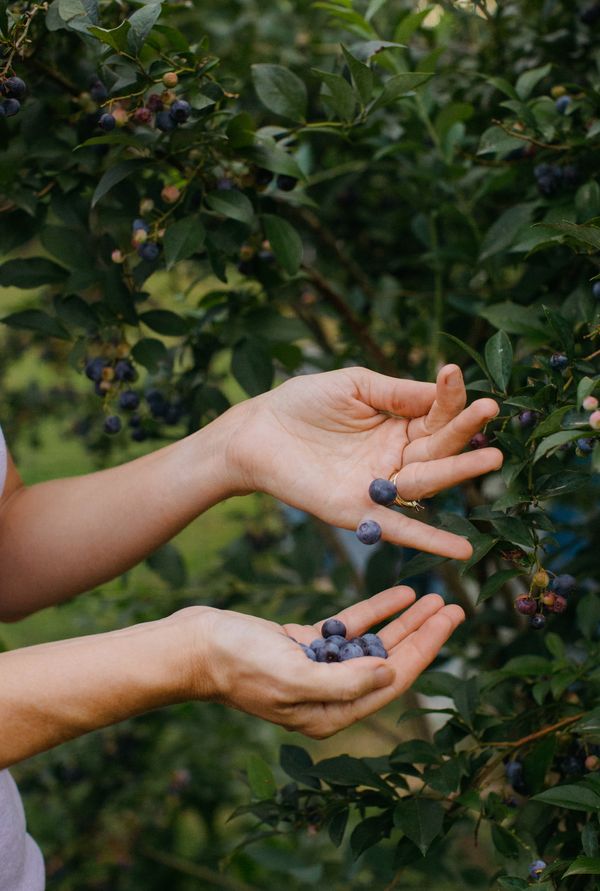
How to Get Started Growing Blueberries
Avoiding beginner blueberry growing mistakes is just one step to getting the blueberry harvest you dream about. Now that my blueberry bushes produce more than our family can possibly eat, give away, and sell, I look back to that first year.
What did I do? I can break it down to 7 simple steps I took that first season. Below you’ll find a 1-minute video outlining those steps, and then you’ll also find more free resources below to help you grow blueberries yourself.
And then, after seven years of successfully growing blueberries, I added two more! With the knowledge from my past harvest, I showed how I planted my new two baby bushes in this video:
I hope you’ve found this post informative and helpful in your venture to grow your own blueberries! Truly, growing and harvesting blueberries have been the highlights of my home garden!
Related Blueberry Growing Posts:
- How to Grow Blueberries in containers and in the ground
- Planting Blueberries: Common Questions Beginners Ask
6-Step Blueberry Planting Workbook

If you want to plant blueberries but you don't know where to start, this FREE 6-step Blueberry Planting Workbook will give you everything you need to know to get started growing your own blueberries!
Enter your e-mail address to download the notebook and receive my "Weekly Garden E-mail" on Fridays, periodic updates on garden resources relevant to you, and get access to a bank of free garden downloads now!
You are also agreeing to our privacy policy.

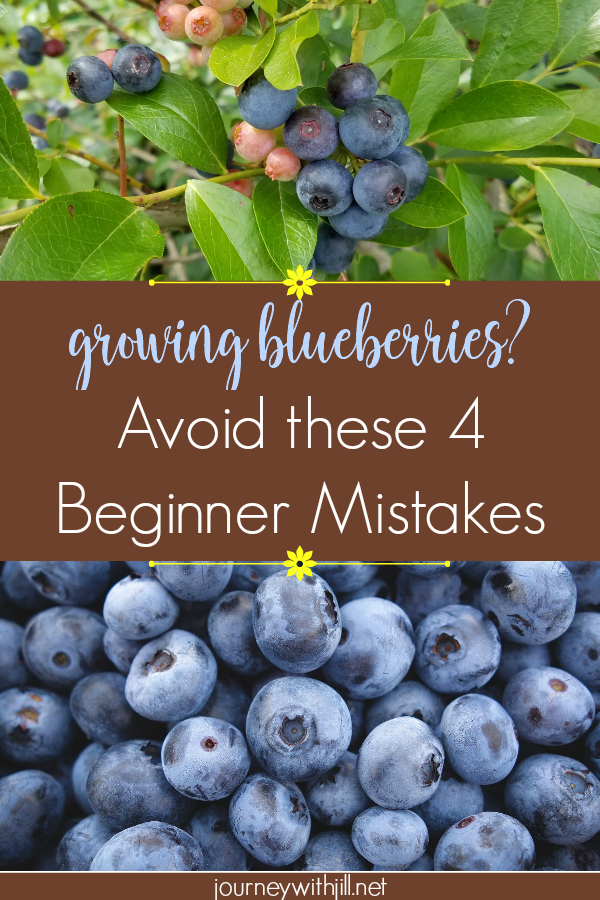
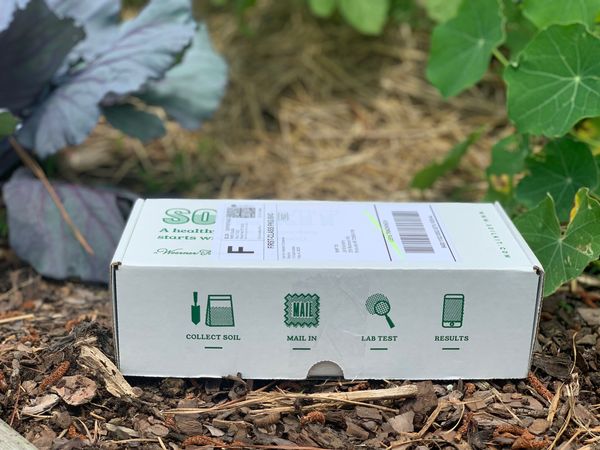


Thanks for these tips. I’ve always wanted to grow blueberries, but I thought they would be hard to grow. After reading this I might give them a try this year.
That’s great! As long as the soil is right, they’re pretty easy, at least in my experience. Best of luck!
2016 , you said you were going to try and grow blueberries AND????? Now, it is 2018 and i am very curious If you did and how are they?
Every year has gotten better and better. We are harvesting so many berries from three bushes that we sell at the local farmer’s market now. The only thing I’ve changed since 2016 is I now add cottonseed meal to my bushes once per year in the early spring to add a nitrogen boost.
What is cottonseed meal and where would someone find it? Thank you for such great info
It’s the discarded material after cotton goes through the cotton gin that is an excellent slow-release fertilizer. I bought mine at a local feed store, but I’m sure it’s available online as well.
Most soil in the central plains are calcarious meaning they have high levels of calcium carbonate in them. You cannot fix the pH to the 4 to 5 level by adding sulfur and at any rate it takes about a year to acidify the soil. My soil is basic in the 7-8 range so I don’ even try to reduce it. I find that containers filled with a mixture of vermiculite, peat moss, and rotted bark works well to hold the pH level low. Vermiculite has a high CEC (cation exchange capacity) and helps buffer the soil against any fluctuation in pH. The real secret is to use moss killer or ferrous sulfate to acidify your soil in the container. This comes as a concentrate and usually has fertilizer dissolved in it. Go to your hot tub dealership and ask for pH strips. Measure the pH of the ferrous sulfate and dilute it 10 times with water to increase your pH one point (pH is a logarithmic scale). Once you have the correct dilution, water the soil in the container. The best water for blueberries is rain water. As for evergreen needles…they will work but the soil must be mostly sand and they must be continually added to the surface The pot will need to be watered every day.
I am going to plant three blueberry bushes this year and would like to know which variety grows best in North West Montana? Also, sun requirements, all day, etc??!!
Hi Kathryn! I’m in the south so the varieties I grow won’t be well-suited to your climate. I found this article that gives some suggestions for varieties in your part of the country. (http://www.gardenguides.com/84014-plant-blueberries-montana.html) I’ve always found purchasing from my local nursery to be a good bet since they carry what’s best suited for my climate. My blueberries thrive in full sun. Perhaps since your summer days are longer than mine, your could tolerate a bit of shade, though I’d be careful on how much. When it comes to fruit-bearing plants, the sun is required to fully develop the fruit. I hope this helps!
As a Master Gardener, your advice is generally good. Soil test is critical. Research shows pine needles are not acidic, although they make a great mulch. Neither are coffee grounds – all the acid went into your cup! Sulfur is your best bet.
I love my blueberry bushes, but the birds get most of the fruit. I’m trying new nets this year.
Thank you, Julie, for your information! I’ve heard the same thing recently about pine needles and coffee grounds, which is good to know so more of us can use it without concern. (My soil is naturally acidic, and with the exception of blueberries, I don’t need to add anything more acidic to my soil.) Regarding birds, so far mine haven’t bothered my bushes, but my bushes are right outside of my dogs’ run. I do have to use netting on my blackberries, though. I hear the netting is the best deterrent. I hope your new netting works well for you!
Jill,
Enjoyed your article. I found from reading your article I made two of the four mistakes. I have 8 bushes, 3 different varieties in well drained soil. I have never checked the PH nor have I gotten around to mulching them. It is something I planned to do this year. I have a hillside on the side of my yard that is useless for much of anything so I decided to plant them there in a terrace arrangement. Hopefully I have allowed sufficient width for the roots. Thanks to your article I will check this out. Last year I got some fruit for my efforts but this year nothing. I have found that our deer love the plants. So a fence is in future plans.
My wife chose to be a stay at home mother, like you have. We have four grown children, all married and in their own Christian homes. You will never be sorry you have chosen this route too. The best to you and your family.
Jill I really did enjoy your blueberry information . I think , realizing it or not all gardeners feel closer to God watching a plant grow in the garden , we can not do it alone . Never forget , He planted the first and best garden Bev . PS We needed fencing this year to deter rabbits , they ate our blueberry plants down to a few sticks with almost no leaves ,but they grew back and even produced some berries up here in Nova Scotia
Same here in Oklahoma! The branches on my blueberry bushes were eaten down in raised beds about a foot off the ground. Discovered the little rabbit droppings inside my bed.
Thank you for the tips! I am just starting to plan a gardenfor our new home, and first on the list are blueberries and strawberries =)
Thanks so much for your advice…. I made almost all the mistakes you mentioned… no wonder I got no fruits last year… We. live in Austria, our garden has very good soil …I’m going right now to get the other plants since I started with only one…. Thank! love your page…
I have wild blueberry plants all over my property, some in the sun and many in full shade. They all produce blueberries, even though one species berries are much tastier then the other. Many of these plants have been here at least 25 years, since we purchased this land. Same with blackberries. Is there a way to move any of them so they are in a location closer to the house and each other? I find new plants often but they are very bushy and 4-5 inches tall, so probably not seedlings.
Wild blueberry bushes are the lowbush variety, which I don’t have any experience in growing. I would still follow the main recommendations especially when it comes to ensuring the new site has a low PH soil. Wild blueberry bushes do have a different growth habit than others, and here is an article I found that might give you some specifics on how to transplant some of the younger bushes on your property: https://www.ehow.com/how_7442306_transplant-wild-blueberries.html
Hallo its Trudi here, just wonna know if you can plant blueberrys from the fruit??
Trudi, I’ve never done this, but here’s an article that might explain more: https://www.gardeningknowhow.com/edible/fruits/blueberries/blueberry-seed-planting.htm
Hi Jill I’ve always had an interest in growing blueberrys but being a city dweller I’m not sure that it’s possible. I’m in N.J. but about 15 minutes from midtown Manhattan N.Y. , truly inner city. I do all raised bed organic gardening and have a 5′ x8′ raised bed that I could use. I just don’t know if it’s large enough for three bushes. thanks for your help. Jack
If I were you, I’d plant two blueberry bushes in that bed. I think three is too many, but with two, you’ll still have cross-pollination. I think it’s completely doable!
I lived in SW Missouri near Springfield and then moved back to my hometown in NW Arkansas. In Missouri I had seven blueberry bushes I planted and put sulphur around plants occasionally. Evidently there is much difference in acidity in just an hour or so drive. The plants in Missouri yielded ten gallons of berries and can’t get them to stay alive in Arkansas. My soil looks like it could grow anything-dark and rich-but blueberries say no. I think the getting the soil ready is the most important thing. Also, I had three different kinds in Missouri which yielded at different times making it nice to have fresh longer. By the way, in case some out there don’t know, don’t wash your blueberries before putting in bags to freeze and the natural “dust” on them make them roll out without sticking together and make great snacks. Thanks for helping people learn about gardening. It’s the best in many ways!
Jill, this is wildly helpful-thank you! I just inherited a potted blueberry plant. Any suggestions for identifying the type of plant? I plan to add another to our garden but want to make sure I’m getting another kind, not just two of the same. Should I be concerned with identification? Thanks again!
Goodness, that’s a good question, but I don’t know. With so many different varieties out there, I think the chances of having two of the same would be slim. If you already have one in your garden, perhaps you could compare the leaves to see if there are subtle variations… but other than that, I’m not sure how you would identify it.
I just planted my first blue berry bush at the end of last week, the back came with two and I planted the start that had some green on it already. This one has started to change and now the leaves are a reddish color?
I have to go to the store to get more soil for my other plant as we are planting these in large pots. Is there any soil that would be best for this specifically? And do you know of any tricks to keep my leaves green and healthy?
You’ve planted it in the soil where other blueberries are growing well? (I’m trying to make sure I understand.) If that’s the case, the soil should be acidic since it’s supporting other blueberry bushes. I’m not sure about the red leaves; that usually doesn’t start occurring until fall. Possibly transplant shock? Newly-planted blueberry bushes don’t typically need any fertilizer; I add nitrogen fertilizer to bushes in their third year.
can i plant 2 blueberrie in 1 pot.
Generally, no. Perhaps there are exceptions, but most blueberry varieties become large and each one will need its own space.
Can I grow blueberries right next to strawberries?
I did this for a few seasons, so the short answer is yes. My strawberries thrived next to my blueberries. But I wouldn’t do it again. Why? Because when the strawberries were at their peak production, it was really hard to pick the blueberries! The strawberry foliage went crazy and spread like a groundcover for the blueberries. We were constantly having to either step on the strawberry leaves or awkwardly lean in to pick blueberries. You could definitely try it but be aware of what could happen, and perhaps leave yourself some room for picking the blueberries if possible.
Hello Jill, I have recently discovered your podcast and have started to binge listen from the start. I have one question concerning pruning blueberry bushes. I have to prune my redcurrant bushes and raspberries and blackberries also need to be cut back, so should I also prune the blueberries and If so, how? Thank you for your great work.
Yes, blueberries should be pruned after they are about 3 years old, but the method is very different from blackberries and raspberries. I use this method that Melissa K. Norris talks about on her site here. The video she has is very helpful: https://melissaknorris.com/prune-blueberries-larger-harvest/
I have four bushes and this year no blue berries. Been adding coffee ground#s an$ the bushes look very healthy. Thanks Pat
How old are the bushes? Did you get blooms?
My father had over 25 years and still producing
There are only 2 mistakes listed here i.e. having only one bush and not checking soil pH. What are the other 2 mistakes please Jill? Is there a second page somewhere? Thanks
Thank you so much for calling this to my attention! There was a technical error on this page and I was able to fix it. You can view all 4 mistakes now.
Hi Jill
For years, I have been harvesting from 2 bushes. After reading your article, I am going to make lots of changes following your suggestions. Obviously, with 2 bushes, I haven’t gotten much and end up buying frozen ones from the store. UGG! But, they are good. So now I will focus on producing a larger crop. I am in southern California What is the best time of year to plant blueberry bushes? And, luckily, I have lots of pine needles from our trees. Anxious to get going and make lots of changes.
Thank you so much for your advice,
Happy gardening, Pam
Hi Pam, I’m not sure the best time to plant in Southern California. I think your best bet is to ask your local nursery. They will also have varieties that might give you a better yield. Most blueberry bushes require a certain amount of “chill hours,” which you may or may not get in your area, but there are varieties that aren’t as picky about those hours from what I understand. That’s why I think your local nursery (not a big box store but an actual nursery) would be your best bet to find out what variety is best and when to plant.
Hi I’m Brad from Cape Town South Africa…i have grown my Blue Berry from seed…All by luck off course…but ow i am concerned that i wont get fruit because i only have one tree/ bush…i have it now for almost 2 years…Its raised from where i planted the seed in a cylinder cement block.. Its about almost 5ft tall..and really has a thick stem..ii want to repot or re-plant it into a container which will be larger than its current root space…but i’m a bit too scared it might wilt and die off. Any advise..should i leave it where it is …it seems quit happy though…i’m just waiting on the flower blooms and fruit…then i am A for Away…Looking fwd to your response. Kind Regards, Brad
I don’t have personal experience growing in containers, but from what I understand about blueberries, if you give them a small container (like you have now), it will not grow as large as it could potentially grow in a larger space, but it would be fine. If you do repot it, I recommend doing it right before it starts budding and leafing out in the spring. Some blueberries can self-pollinate, so I’d keep an eye on the blossoms and if you only have flowers but no fruit, you know you need another.
Hello, thanks so much for these steps! Our soil is high on PH so we are going to add some sulfur and do our best to make the soil right! So I was just wondering if we can plant 1 blueberry bush somewhere and then plant a different variety farther away? Would it still produce more fruit or does the bushes have to be close together since there isn’t as much room for us? Thank you?
They need to be fairly close together, though I’m not certain on precise distance — I’m thinking 20 feet max? The cross-pollination happens with bees, and they’ll be visiting flowers usually all at once. When mine are in bloom, the bees go from bush to bush. Here’s another blog post / podcast episode that speaks more to amending your soil to lower the pH: https://journeywithjill.net/gardening/2018/02/20/growing-blueberries-interview-with-lee-reich/
Do you recommend not picking the berries the first year?
That’s the official recommendation, but I never have bee able to help myself. 🙂 I don’t know if the subsequent harvests were affected because I didn’t test it, but since I seemed to get expected harvests the second and third years (and beyond), I don’t regret enjoying the first year’s fruit. 🙂
So plant at least a couple of bushes of blueberries but differnt types?
That’s correct.
i planted blueberries and grew them for 4 years and they did poorly.
i live in the northwest were we get snow and the temp gets in the low 10 to -10 and it gets cold
do i need to shield them? i was going to plant them on the east side between my apple trees and that’s were we get the coldest winds is that a mistake.
how protected do i have to get?
thank you for all your information i am going out to day and get pine needles and we always save the coffee grounds it makes our grass grow wonderful we don’t put chemicals on in anymore.
Hi Patti, since I don’t live in an area that gets this cold, I can’t tell you for sure. I recommend you call your local cooperative extension agent and ask about the cold tolerances of the ones you have relative to your climate. I do believe it depends on the kind, though. I grow rabbit eye blueberries that aren’t ideal for cold weather. If you bought from a local garden center or nursery, I’d imagine they’re ideal for your climate, but if you ordered them online, you might just double check.
I was just giving 4 blueberry plants that are still in the black pot they come in from the store. I live in Wisconsin in a zone 5 it’s October now. What should I do with these plants to keep them alive? Should I plant them or should I leave them in the pot outside and over with hay? Do I bring them in door like to the basement? I’m really not sure.
That’s a good question, Kristi. Not knowing the kind or having personal experience with Wisconsin winters, I’d advise you to contact your local cooperative extension service and ask an extension agent. Generally, plants in the ground outside are going to be better insulated than plants in pots. My gut instinct would say to plant them in the ground AND cover them with a thick mulch of some kind (beware of hay because it may have been treated with herbicides which you don’t want near your blueberries). But before you plant them now on my advice, please get a second opinion from someone local. You don’t want to lose those blueberries!
Great article, thank you! I had great beginner’s luck with my first blueberry bush, but it died. Next time I plant blueberry. I will avoid these mistakes that you mentioned. Thanks for sharing.
I have one plant, this year I will buy a second to help with pollination. How close together do they need to be?
About 20 feet or less is generally recommended. Mine are 5’ apart.
How deep to I need to dig to plant the blueberry bush? I’ve grown hydroponic but this summer will be my first outdoors.
It just needs to be planted at the same depth as it was in the container.
I have a blueberry bush that I bought about 2 years ago. It is in a pot but I left it outside during the Texas freeze in February (bundled up with lots of other large potted plants and wrapped with frost blankets). It was getting big and had tons of buds on it before the freeze. It didn’t die but it lost all its leaves and now the buds are of course, dead. Many of my other plants are slowly coming back but I’m not sure what to do now. Should I prune it? How much? I do plan on getting another one.
I guess I’m not sure how you didn’t die altogether? Do you see new growth? If so, I’d prune after I’m sure which branches are dead and which ones are not.
Thanks so much! I’m going to try planting some for my grandkids!
I have 3 bushes that were planted a few weeks ago and are already blooming. They aren’t supposed to bloom until the end of June. Should I pop the blooms off? Will it bloom again in June when it is supposed to? I’m in the Boise Idaho area so it is not freezing anymore, but gets down to 37 at night.
In my experience, blueberries only bloom once, and mine bloom in March and April. If you pinch the blooms off now, that’s actually recommended for the first year anyway, but I’ve never done it myself. I’m not sure why they would not be supposed to bloom until June, but if it’s because of where you are located, most likely they were grown in a more southern area, and next season they will bloom at the proper time. I wouldn’t worry about it this year.
Hi Jill
I live in Perth Western Australia warm summer 30+C sandy soil which can remedied
Would our climate be suitable for growing Blueberries
Thanks so much for your informative articles
Regards Gavin
I’m not sure about your climate, but the summers here can be similar. The blueberries can take our heat. It’s the winter you probably want to check on. Blueberries need over 400 chill hours in the winter, depending on the variety. If you can amend the soil to the right kind (acidic, well-draining, but plenty of water), the winter temperatures would be the thing to consider.
I recently added strawberry plants under my blueberry plants. The strawberries did great but I am getting very few blueberries. How can I up production? Should I remove the strawberries?
I just wanted to say thanks for the information. I am a beginner and have already learned so much from you.
Thank you!
I came across your article on blueberries and wanted to thank you for the information. I am a beginner gardener and a hedge trimmer by profession. I really found your article very helpful!
.
Thank you for an awesome post about growing blueberries! I’ve been thinking of starting to plant some and it sounds like you have a lot of experience.
Your article was so helpful. I’m interested in your opinion since this seems like something newbie gardeners might not consider important- but is pretty crucial for water conservation. Thanks again!
Great article. I’ve had 2 goes at blueberries. Both times they did well for a few years, I had followed your steps, they were in pots as we have alkaline soil. Both times they all died after I mulched with my neighbours Christmas tree. I suspect it was treated with something poisonous. I have 4 new bushes coming soon and I will stick to mulching with coffee and wild pine needles in future!
I have always used peat free compost as peat takes ages to form and comes from fragile environments. It is also a good carbon sink, as important as rainforests.
I was given blueberry bushes as a gift so I was given two of the same variety, will that be okay for them to bloom or they have to be two different varieties?
It depends on what kind they are. Many types can be self-pollinating with the same variety, but others (like the rabbiteyes I grow) need a different one. More information can be found here to help you know what you have: https://www.ars.usda.gov/pacific-west-area/logan-ut/pollinating-insect-biology-management-systematics-research/docs/blueberries/#:~:text=There%20is%20evidence%20that%20cross,ovules%20and%20yield%20a%20berry.
This is so helpful! What a great way to get started!
Thanks for sharing! Is one kind of mulch better than another?
I have an article here that discusses the pros and cons of 9 different options: https://journeywithjill.net/gardening/2021/05/04/9-organic-mulch-options-for-the-vegetable-garden/
Hello this is my first time growing blueberry’s.. my plant looks great! I already have flowers on it..and only planted like a month ago ..is this good?
That’s normal for a plant that’s probably about a year old or more. Some people recommend to pinch off the blooms so the plant can focus on root growth. I didn’t and have never done a side-by-side so I can’t speak to whether it will help or not, but mosts garden experts recommend to do so. I just wanted any small bit of berries I could get that first year. 🙂
Super helpful!
I garden in zone 3 with raised beds. Each bed is 2 feet deep, 2 feet wide and 12 feet long. One is tented and the others can be. Each bed is 3 feet above ground as I garden from a wheelchair. I have always wanted to try blueberries and now I have some ideas to try. I have never tested my soil but created it using garden loam plus composted manures My crops do well despite heat. Next season berries are my newest venture. Thank you for the tips
We discovered by dumb luck, after spreading red lava rock in our flower beds and newly planted blueberry bush beds, (in place of beauty bark or other decorative rock), that the lava rock helped produce the most amazing and plentiful quarter sized blueberries we’d ever seen ~ quite shocking actually! Lava rock is of course volcanic, and naturally acidic ~ so every time you water your berries they get a dose of lava dust and they absolutely love it!!! Just use the red rock around each plant as a mulch and you won’t believe the results. Hugs, and happy blueberries to all!!!
I’ve never heard of that! Thank you for the tip!